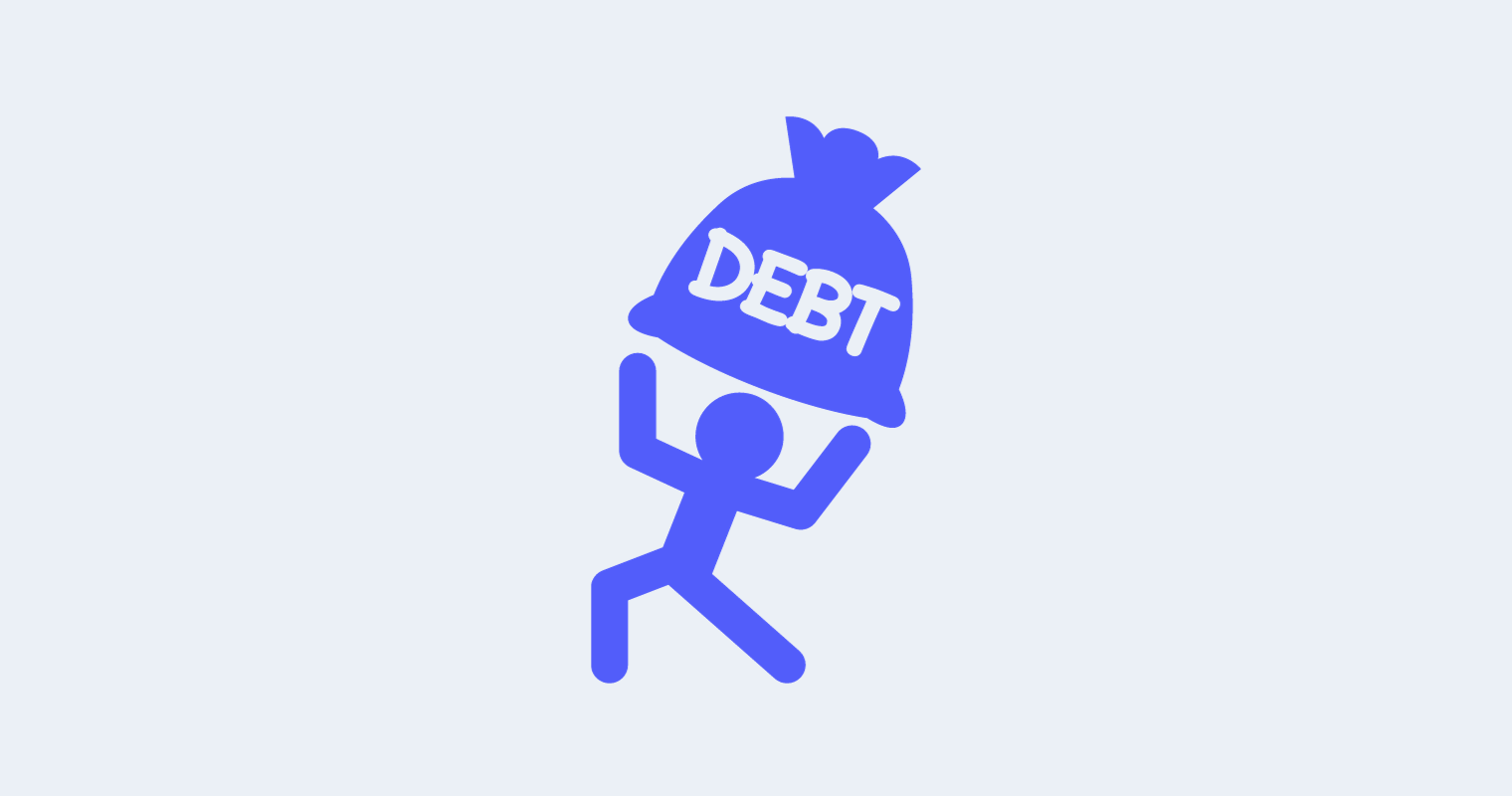Ever built a house of cards? You start with a solid base, right? What happens if you keep stacking levels without paying attention to the structure? It starts wobbling. A slight breeze or an accidental touch could bring down your skyscraper card castle.
Now think about software development.
In the rush to deliver features fast and meet deadlines, teams often cut corners. That could include code quality, design or testing processes. It’s like adding shaky levels to our card tower. This is what we call ‘technical debt’.
While manageable at first glance, over time it becomes overwhelming. The weight of poor decisions threatens to collapse your entire project. Like that delicate house of cards.
We’re about to explore what causes these coding debts and the different types they come in.
Understanding technical debt
Just like financial debt, technical debt is something you’d want to avoid. But what exactly is it in the context of software development?
Technical debt is the extra work that piles up when you take shortcuts. It’s common during initial development stages.
Developers often take shortcuts to meet deadlines or to quickly fulfill requirements. At some point, that work needs to be completed.
A simple metaphor
Let’s compare taking shortcuts and quick fixes in coding to buying a house with a mortgage. You get the house now but pay for it over time with interest.
Likewise, by taking shortcuts and quick fixes in coding you accumulate ‘debt’. It’s kind of like borrowing. This will need fixing later (repayment). Usually, at higher costs due to accrued complexities (interest).
A deeper dive
Ward Cunningham coined the term “technical debt.” He used it as a metaphor to explain why faster isn’t always better in software development.
He explains how rushing through code or design can lead to suboptimal solutions. These eventually need refactoring, thus accumulating ‘debt’ that needs paying back later.
This concept serves as a critical reminder for teams about long-term thinking. Careful planning in the product development processes helps to avoid technical debt.
Causes of technical debt
Comparing technical debt to financial debt is an easy way to conceptualize it. Like buying a house on credit, sometimes you have to borrow to quickly deliver software.
There are many reasons why you’d have to do that.
The first cause is business pressure. When you urgently need a new feature, developers might skip best practices. They often create quick-fix solutions. This approach can pile up ‘interest’ that needs repayment later.
Lack of process or documentation also contributes. Without clear guidelines or adequate documentation, teams may unintentionally add technical debt. Repeating past mistakes can quickly make technical debt pile up.
An often overlooked source is necessary trade-offs. Sometimes creating an imperfect solution now allows for valuable learning and improvement later. But remember – this kind of strategic decision should be intentional and controlled.
Finally, low-quality code caused by lack of skill or understanding is a factor. This highlights why ongoing developer education is so important.
Type of technical debt
Steve McConnell proposed two broad categories in 2017: intentional and unintentional technical debt. Intentional debt refers to strategic decisions made consciously. Unitentional debt results from subpar work or lack of foresight.
Martin Fowler expanded on this by introducing his “Technical Debt Quadrant.” This further classifies technical debt. It looks at intent (deliberate or inadvertent) and context (prudent or reckless). This quadrant offers a more nuanced understanding but still leaves some aspects unaddressed.

The Software Engineering Institute’s paper on technical debt expanded even further. Published in 2014, Towards an Ontology of Terms on Technical Debt explores 13 types of debt. Let’s look at them now.
The 13 types of technical debt
There are many types of debt you can rack up. Each type has its unique characteristics and challenges.
Architecture debt
This type occurs when system design principles are compromised for faster delivery. This leads to a poorly structured system that may be difficult to maintain or scale.
Build debt
This is a result of inadequate build and release processes. It often manifests as frequent integration issues and long deployment times.
Code debt
This is when developers take shortcuts or use subpar coding practices. Usually, this is done to meet deadlines. Think of it as a hastily done DIY project; sure, you’ve got your shelf up quickly. But, the wonky alignment may cause issues down the line.
Defect debt
This arises when known defects aren’t addressed promptly due to other priorities. This causes an accumulation over time.
Design debt
Caused by compromising on user interface (UI) and user experience (UX) design aspects. This can lead to lower customer satisfaction levels later on.
Documentation debt
Lack of adequate documentation is an often overlooked type of debt. It makes it hard for team members or external contributors to understand how things work. This slows down progress in the long run. It happens when teams overlook creating comprehensive documentation for their software projects. This is akin to assembling IKEA furniture without a manual.
Infrastructure debt
This refers to poor decisions about infrastructure setup like servers or databases. It could affect performance and scalability.
People debt
This refers to the lack of skilled personnel or inadequate training. It often leads to slower progress and lower quality output.
Process debt
Inefficient processes that slow down development cycles and lead to wasted effort.
Requirement debt
This arises when there’s a lack of clarity in requirements. It leads to wrong assumptions and rework.
Service debt
This happens when third-party services used in your product are not managed properly. This often causes reliability issues.
Test debt
Last but not least, there’s test debt. This is inadequate testing due to insufficient time or resources. Often it’s the result of neglecting test automation. This can lead to longer testing cycles as the codebase grows. It’s akin to skipping vehicle inspections before a long road trip. It can lead you into uncharted territory with potential breakdowns.
Impact of technical debt
Rushing software development might get your product to market faster. But just like monetary debts need to be repaid with interest over time, so does technical debt.
The immediate impact is clear. You save time and resources in the short run by cutting corners or opting for quick-fix solutions. But, these savings come at a price later on when it’s time to pay back that ‘loan’.
You may have an application running smoothly today. But, beneath the surface lies accumulated code issues waiting to explode tomorrow. And often, they will.
Neglected debt accumulates interest
The more you neglect this technical debt, the higher ‘interest’ piles up. It often decreases productivity and increases maintenance costs.
Decreased productivity over time
Your team’s efficiency can take a hit. Developers spend more time fixing bugs than working on new features or improvements. It also impacts morale; nobody enjoys slogging through messy code bases.
Affect on product quality & maintenance
Technical debt directly impacts product quality. It can cause systems to become unstable, unreliable, difficult to maintain and extend. This not only affects your team’s productivity. It also hampers user experience, leading towards loss of customers.
Budgetary implications
There are financial implications too. The time spent fixing issues arising from poor-quality code is costly. Instead, you could develop new features or improve existing ones. (like driving business growth for example). Managing technical debt effectively should be an integral part of budget planning.
Influence on team morale
Last but not least, technical debt can negatively impact team morale. Constantly fixing issues rather than working on new projects can be demotivating. It’s important to strike a balance between delivering fast and maintaining code quality.
Technical debt isn’t necessarily bad
Don’t view technical debt solely as something negative. Consider seeing it as an integral part of strategic decision-making within product development. When managed properly it allows you to push out new features faster. How do you manage it properly? Regular debt paydowns are a great tactic. Sometimes that’s necessary to meet deadlines and immediate customer needs.
So, is technical debt bad? The answer isn’t black or white. Like financial debt, it’s not inherently bad if managed wisely. But, don’t let it pile up without addressing the underlying issues. It could lead to serious problems down the line.
Strategies for managing debt
Addressing technical debt needs a well-thought-out strategy. It’s not about quick fixes, but steady and consistent efforts.
Maintain good documentation
Good documentation can save you from unnecessary confusion later on. It acts as a roadmap, letting developers know where potential issues might lie.
Prioritize refactoring
Refactoring should be an ongoing task in your project lifecycle. This involves rewriting parts of code to improve its quality without changing functionality. You nip the problem at its bud before it grows into unmanageable proportions.
Incorporate code reviews
Routine code reviews ensure that new changes don’t introduce more debts. They also help identify areas needing refactoring.
Create a tech debt list
A tech debt list gives an overview of all known debts in your project – big or small. You can use this list to plan and prioritize which debts need attention first. You should look at their impact on the broader product development process.
Preventing technical debt
To stop technical debt from piling up, a balanced approach to development is key.
The first strategy is maintaining quality code practices.
Martin Fowler’s principle of continuous refactoring helps keep the code clean and manageable. Focus on consistently refining and improving your codebase. This prevents bad design decisions or quick fixes from accumulating into serious debt.
Next comes Maintaining Documentation.
Maintaining a clear understanding of the codebase is essential. Having it become muddled and opaque can be detrimental. Regularly updating documentation lets new team members get on board quickly. This prevents adding to your project’s technical debt.
Last but not least: Frequent Testing.
An effective testing framework plays a vital role in keeping technical debt at bay. Automated assessments furnish immediate info about what is successful. And more significantly, what isn’t.
Balancing speed with quality
In software development, there are times when speed takes precedence over quality. That’s okay as long as it doesn’t become habitual.
Try to balance rapid delivery and high-quality output. It ensures that shortcuts taken today won’t lead to more time-consuming repairs tomorrow.
Promoting collaboration between developers and product managers
In managing tech-debt effectively, communication between developers and product managers is essential. Shared understanding of project goals minimizes chances for misunderstanding or oversights. These often lead to future problems. An ounce of prevention here saves pounds of cure later.
Tools for identifying and managing technical debt
It’s essential to have tools that can help spot and manage technical debt. Let’s look at some tools to help you identify and manage technical debt.
SonarQube is a well-known static code analysis tool. It’s great at detecting potential issues like bugs or code smells. It lets developers see where their coding may lead to future problems.
Another good tool is ReSharper. This handy tool highlights errors as you type and suggests quick fixes. You’ll catch those sneaky debts before they even become an issue.
Then there’s JFrog Xray. With deep recursive scanning, it gives visibility into your software components’ vulnerabilities.
With these weapons in hand, managing technical debt becomes less daunting. So give them a try. Your future self (and your product) will thank you for it.
The role of team culture
When it comes to managing technical debt, your team’s culture plays a significant role.
First off, communication is key. A team that communicates effectively can better understand and tackle complex issues.
Atlassian suggests that open dialogue about coding and design decisions helps prevent misunderstandings. This helps avoid codebase complications.
Nurturing an Agile mindset
An agile mindset goes hand-in-hand with reducing tech debt. This approach encourages continuous improvement which helps keep the code clean and maintainable.
Promoting responsibility
Taking responsibility for your work has a profound impact on managing technical debts. Make developers feel accountable for their codes’ quality. They’ll be more likely to avoid shortcuts that may lead to problems down the line.
Leveraging peer reviews
A healthy peer review practice can catch potential issues early on. By constructively critiquing each other’s work, teams help each other deliver high-quality output. They also avoid costly future rework due to overlooked bugs or inefficient solutions.
Fostering learning opportunities
Innovation often brings risks of accruing tech debts. But, by fostering learning opportunities, these challenges become stepping stones towards mastery.
Remember – cultivating a supportive environment makes dealing with tech debts less daunting.
FAQs
What is technical debt?
Technical debt is the future cost of reworking or fixing quick-and-dirty code solutions. These are often implemented for immediate progress. But, they eventually need to be addressed.
What is an example of technical debt?
An example could be skipping code documentation to speed up delivery. This may lead to confusion and time wastage when others need to understand that code later on.
Is technical debt good or bad?
In moderation, it’s not necessarily bad. Sometimes a project needs fast results. But if unchecked, it can become detrimental. It can impact productivity and cause major setbacks in the long run.
Why is technical debt a problem?
If can slow down teams, increase bug risks, and affect product quality over time. This ultimately makes further changes more expensive and complex.
Wrapping it up
So, what is technical debt? It’s the shaky layers in your software project. Those quick fixes and cut corners that accumulate over time.
We’ve dug into its causes, both intentional and unintentional. We’ve uncovered its types: code debt, design debt, documentation debt, and test debt.
We learned how it impacts projects immediately and long-term. But we also explored ways to manage it with smart strategies and tools.
Remember — preventing technical debt starts at the team level. The culture you foster can make or break your efforts against this silent project killer.
In the end you need to actively work to reduce its effect on your product.






